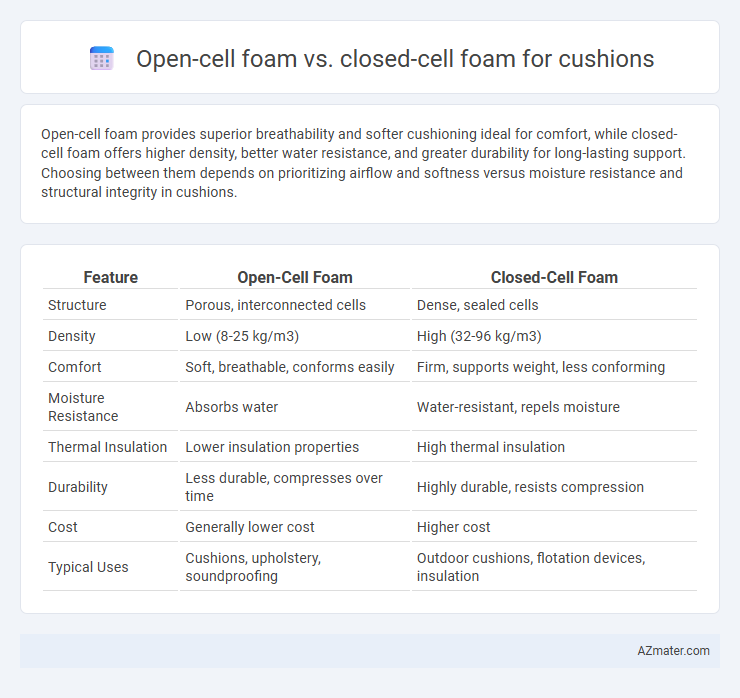Open-cell foam provides superior breathability and softer cushioning ideal for comfort, while closed-cell foam offers higher density, better water resistance, and greater durability for long-lasting support. Choosing between them depends on prioritizing airflow and softness versus moisture resistance and structural integrity in cushions.
Table of Comparison
| Feature | Open-Cell Foam | Closed-Cell Foam |
|---|---|---|
| Structure | Porous, interconnected cells | Dense, sealed cells |
| Density | Low (8-25 kg/m3) | High (32-96 kg/m3) |
| Comfort | Soft, breathable, conforms easily | Firm, supports weight, less conforming |
| Moisture Resistance | Absorbs water | Water-resistant, repels moisture |
| Thermal Insulation | Lower insulation properties | High thermal insulation |
| Durability | Less durable, compresses over time | Highly durable, resists compression |
| Cost | Generally lower cost | Higher cost |
| Typical Uses | Cushions, upholstery, soundproofing | Outdoor cushions, flotation devices, insulation |
Introduction to Foam Types for Cushioning
Open-cell foam consists of interconnected air pockets, making it softer and more breathable, ideal for cushioning that requires pressure relief and airflow. Closed-cell foam features tightly packed cells filled with gas, providing higher density, rigidity, and superior moisture resistance, suitable for firm support and durability. Choosing between open-cell and closed-cell foam depends on the desired balance of comfort, support, and environmental factors in cushioning applications.
What Is Open-Cell Foam?
Open-cell foam is a lightweight cushioning material characterized by interconnected air pockets that create a soft, breathable structure ideal for comfort and shock absorption. Its porous nature allows air and moisture to pass through, making it suitable for applications requiring breathability and flexibility, such as seat cushions and mattresses. The open-cell design offers lower density and enhanced softness compared to closed-cell foam, but it provides less water resistance and durability in high-impact environments.
What Is Closed-Cell Foam?
Closed-cell foam is a dense, rigid material characterized by tightly packed cells that are completely sealed from one another, making it highly water-resistant and durable. Its structure offers superior insulation, moisture resistance, and support compared to open-cell foam, which has interconnected cells that allow air and moisture to pass through. Closed-cell foam is ideal for cushions requiring high structural integrity, enhanced cushioning, and long-lasting performance in outdoor or high-moisture environments.
Key Differences: Open-Cell vs Closed-Cell Foam
Open-cell foam offers a softer, more breathable structure with lower density and higher sound absorption, ideal for cushions requiring flexibility and comfort. Closed-cell foam provides a denser, waterproof, and more durable material with excellent insulation and resistance to moisture, making it suitable for outdoor or heavy-use cushions. Key differences include open-cell's permeability and cushioning softness versus closed-cell's rigidity, moisture resistance, and superior support.
Comfort and Support Comparison
Open-cell foam provides superior comfort due to its soft, breathable structure that allows air to flow freely, making cushions feel plush and cozy. Closed-cell foam offers firmer support with its dense, water-resistant construction, ideal for maintaining shape and providing stability over time. Choosing between the two depends on the desired balance between softness and structural support in cushion applications.
Durability and Longevity
Closed-cell foam offers superior durability and longevity due to its dense, rigid structure that resists moisture, compression, and wear over time. Open-cell foam, while softer and more breathable, tends to degrade faster with prolonged use because its porous structure absorbs moisture and loses shape more quickly. For cushions requiring long-term resilience and structural integrity, closed-cell foam is the preferred choice.
Moisture Resistance and Breathability
Closed-cell foam offers superior moisture resistance due to its dense, impermeable structure, preventing water absorption and making it ideal for cushions exposed to damp environments. Open-cell foam excels in breathability, allowing air circulation that enhances comfort and reduces heat buildup but absorbs moisture more readily. Selecting between these foams depends on balancing moisture protection needs with ventilation preferences for cushion applications.
Cost Efficiency Analysis
Open-cell foam offers superior cost efficiency for cushions due to its lower material density and cheaper manufacturing process, making it an economical choice for budget-conscious applications. Closed-cell foam, while more expensive upfront, provides enhanced durability and water resistance, potentially reducing replacement frequency and long-term costs in high-use or outdoor environments. Evaluating total lifecycle expenses and usage conditions is essential to determine the most cost-effective foam type for cushion applications.
Best Applications for Each Foam Type
Open-cell foam, known for its soft, breathable structure, is ideal for cushioning applications requiring comfort and pressure relief, such as upholstery, mattresses, and soundproofing panels. Closed-cell foam offers superior water resistance, durability, and support, making it best suited for outdoor cushions, heavy-duty seating, and flotation devices. Choosing between open-cell and closed-cell foam depends on factors like moisture exposure, firmness requirements, and intended cushion longevity.
Choosing the Right Foam for Your Cushion
Open-cell foam offers superior breathability and softness, making it ideal for cushions that require comfort and airflow, while closed-cell foam provides higher density and water resistance, suitable for outdoor or moisture-prone environments. Choosing the right foam depends on the cushion's intended use, with open-cell prioritizing comfort and closed-cell focusing on durability and support. Consider factors like cushioning needs, exposure to moisture, and desired firmness when selecting between these foam types.

Infographic: Open-cell foam vs Closed-cell foam for Cushion
 azmater.com
azmater.com